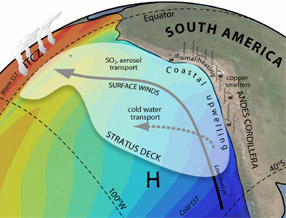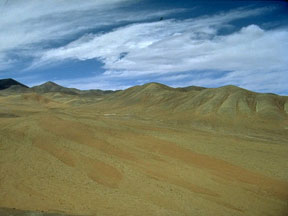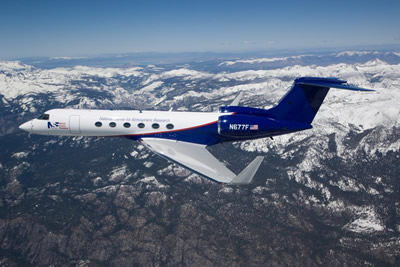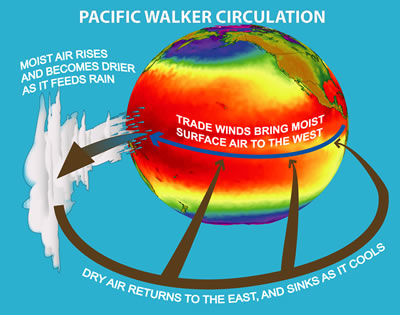The Walker circulation is made up of trade winds blowing from east to west across the tropical Pacific Ocean (blue arrow), bringing moist surface air to the west. In the western tropical Pacific, the moist air rises, forming clouds. The rising air becomes drier because most of its moisture falls to the surface as rain. Winds blow from west to east, moving the now drier air toward South America. The dry air returns back to the surface in the eastern tropical Pacific, completing the loop.
Click on image for full size
Image courtesy of NOAA Geophysical Fluid Dynamics Laboratory
Walker Circulation
The Walker circulation is an ocean-based system of air circulation. This system influences weather on the Earth. Normally, the warm, wet western Pacific Ocean is under a low pressure system, and the cool and dry eastern Pacific Ocean is under a high pressure system. This causes surface air to move east to west, from high pressure in the eastern Pacific to low pressure in the western Pacific. Higher up in the atmosphere, winds flow from west to east, and this completes the loop.
The Walker circulation is part of the normal weather conditions in the tropical Pacific Ocean. Normally, the western Pacific has warm, wet weather and eastern Pacific has cool, dry weather.
The Walker circulation changes every few years, and this changes the weather. This is part of the El Niño-Southern Oscillation (ENSO). When the Walker circulation weakens, it is called El Niño. When the Walker circulation is very strong, it is called La Niña. El Niño and La Niña impact the weather in North and South America, Australia, and Southeast Africa. El Niño and La Niña can cause flooding, droughts, and increases or decreases in the number of hurricanes that form.
You might also be interested in:

Wind is moving air. Warm air rises, and cool air comes in to take its place. This movement creates the winds around the globe. Winds move at different speeds and have different names based on their speed.
...more
Hurricanes form in the tropics over warm ocean water. The storms die down when they move over land or out of the tropics. At the center of the rotating storm is a small area of calm weather and clear skies
...more
The winds in the Southeast Pacific mainly blow from south to north. They affect the weather and climate in the region. They also affect the climate in other places around the world. Air near the equator
...more
The Atacama Desert is one of the driest places on Earth. The Atacama is in the country of Chile in South America. In an average year, this desert gets less than 1 millimeter (0.04 inch) of rain! It is
...more
Rainbows appear in the sky when there is bright sunlight and rain. Sunlight is known as visible or white light and is actually a mixture of colors. The sun's rays pass through millions of raindrops. A
...more
It takes the Earth one year to travel around the sun one time. During this year, there are four seasons: summer, autumn, winter, and spring. Each season depends on the amount of sunlight reaching the
...more
Scientists sometimes travel in airplanes that carry weather instruments in order to gather data about the atmosphere. These research aircraft bring air from the outside into the plane so scientists can
...more















